Why Does My Netgear Router Just Dtop and Then Start Again
If you experience Wi-Fi dropping signals, disconnections, or can't connect a device to your network (at the expected speeds), this mail service is for yous.
I wrote this piece based on the myriads of questions I've gotten daily. I'll explicate how Wi-Fi works and walk you through a list of specific tricks that will likely make things ameliorate.
"Probable" because in that location's a chance it's non possible to remedy the problem at your detail place. Sometimes, that'south merely the nature of the wireless connection. But at least you'll know you've done all you could to improve your Wi-Fi situation.
Before continuing, though, make sure you're comfortable handling a home router.
I'd recommend you read this entire post, but returned readers can use the Table of Content below to check on just the newly added info. Also, if you run into something unfamiliar, follow the hyperlink text to the folio where I explain it further.
Past the mode, this post is almost Wi-Fi dropping and other related bug within your local network. For broadband-related problems, bank check out the related mail service in the box below.
Dong's note: I commencement published this post on March 29, 2020, and last updated information technology on April xx, 2022, to include additional upward-to-date and practical tips. This post is frequently updated.
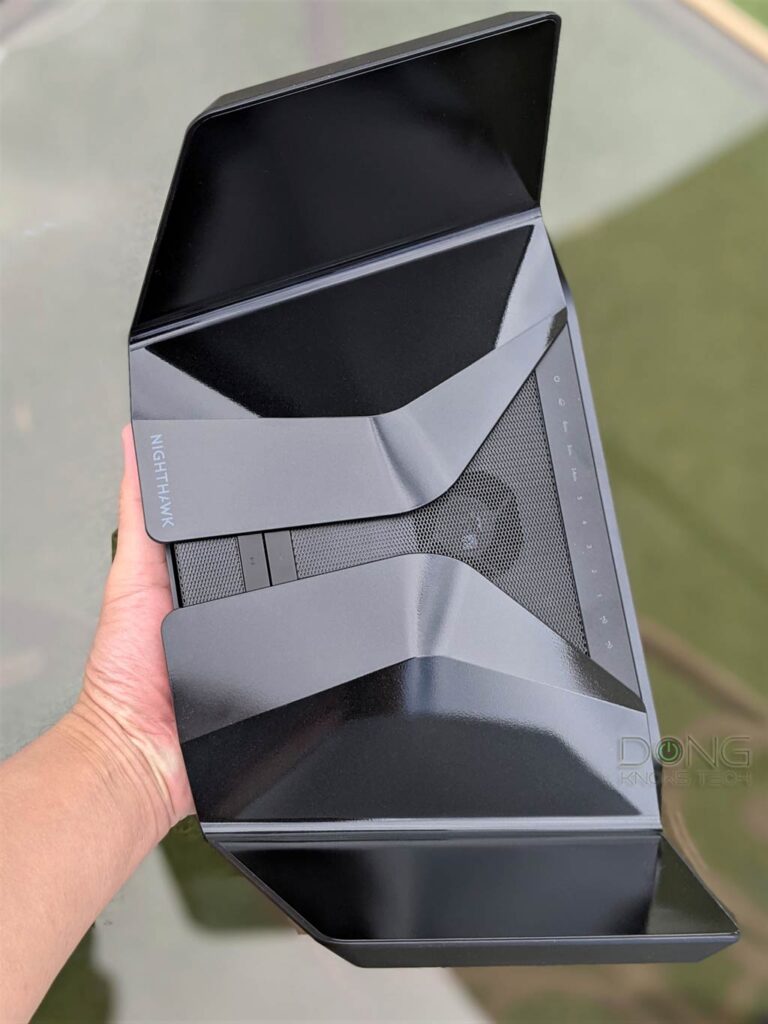
Wi-Fi signals (and speeds): A brief perspective
Like all things, there's more to Wi-Fi than what we tin see — and in this case, we run into nil in the first place. All the same, it'due south a good thought to empathise how something works to a certain level before fixing information technology.
Hither goes:
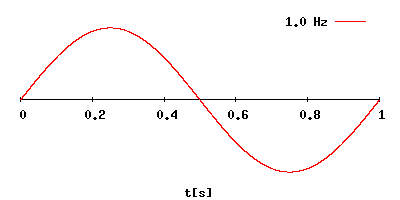
To visualize how wireless transmissions occur, drop a pebble in a still pond and watch the ripples motion outwards. Permit'southward called that our Wi-Fi signals — measured in Hertz.
Now, throw in another rock at a unlike spot. That's the neighbor's Wi-Fi signal. Toss a rubber duck in the water! That's a microwave. See what happens when the ripples collide? Those are indicate distortions — it'due south when Wi-Fi drops.
It'southward worth noting that the swimming is never entirely serene in the first identify. There are other things — wind, insects, fish, droppings, the liquid's viscosity, etc. — already affecting the ripples created by the original pebble.
So, there are things around the states that adversely affect Wi-Fi signals at whatever given time. The fact Wi-Fi ends up working at all, let alone delivering hundreds of megabits of data 24/7, is already quite remarkable.
The point is: signal distortion and disconnection are part of radio manual'due south nature. As the radio waves travel through the air, they meet many things that alter their integrity.
It'south our man nature to take things for granted. Equally Wi-Fi improves over the years, nosotros've expected more than out of information technology. The hype from the media and misleading advertisement from hardware vendors are too to blame.
So, fix your expectations right:
- There's no magic! Your Wi-Fi is never as fast every bit the vendor claims. It's much slower.
- Wi-Fi always fluctuates in speeds and never is equally practiced as a good quondam network cable.
- Your dwelling is never platonic for Wi-Fi, and you should be happy near that — the vacuum space is ideal for Wi-Fi.
- Wi-Fi, like facts, is contained of how you feel or what you (want to) believe.
The lesser line: Don't await Wi-Fi to suit you. Instead, try to sympathise it, and maybe yous'll get lucky.
Wi-Fi dropping, disconnections, and failure to connect: The general causes
To have adept Wi-Fi, you beginning and foremost demand the proper hardware.
So get the best router or mesh arrangement for your needs and prepare information technology up properly. Hint: Information technology'south all-time to get your abode wired.
Just even the all-time network nonetheless has to bargain with the following three connexion-related issues.
A. Hardware incompatibility
Incompatibility is probable the most common crusade of Wi-Fi problems.
In that location are and then many hardware vendors with lots and lots of devices. It'southward tough to keep all of them interoperating well in all scenarios. That'south non to mention hardware and software quality and dissimilar Wi-Fi standards and tiers.
But at the core of it, this issue derives from the fact many broadcasters (routers) and the clients (phones, laptops, IoT devices) don't share the extra nuances designed to improve speeds.
Instead, they just share the basic level of the involved Wi-Fi standards, enough for them to (barely) work together.
B. Signal saturation or interferences
Signal saturation is also typical, specially in urban environments.
On your phone'due south Wi-Fi scan, y'all tin can come across that at that place are always more Wi-Fi networks than your own. Each represents a broadcaster and takes up a portion of the airspace.
The more Wi-Fi broadcasters of different types in the vicinity, the more likely you'll have to deal with signal interference. That's non to mention other types of devices (like microwaves, cordless phones, RADAR, etc.) that might as well utilise the same frequencies.
Interference: The curious example of Bluetooth
Bluetooth also uses the 2.4GHz band. Notwithstanding, it'due south very different and by and large won't crusade (much) interference.
Bluetooth is mostly for peer-to-peer and therefore doesn't require a stock-still aqueduct. Equally a result, it tin can "channel hop," –pregnant it picks and chooses the most unoccupied channel to apply in real-fourth dimension. And information technology does that up to 1600 times per second.
As a issue, generally, Bluetooth doesn't touch on Wi-Fi. Except in two instances:
- The 2.4GHz band is fully saturated: Now, no hopping tin aid, but, well, chances are not-Bluetooth devices saturate it.
- Hardware sharing: This only applies to clients. Many (older) Wi-Fi/Bluetooth philharmonic fries don't work well when both wireless functions are used simultaneously.
It's safe to say modernistic Bluetooth devices more often than not don't cause Wi-Fi problems.
C. Other factors
There are other factors, too. Some of them you accept no control over.
Examples are hardware problems, RADAR activities, thick walls, or even a jammer near your home. Or the fact your home is made of materials that block radio waves.
***
Now that nosotros have identified the issues let'due south notice out how to prepare them.
How to prepare Wi-Fi dropping and connection bug
And there are 2 sides to a wireless connection, the broadcaster and the receiver.
Each might accept issues of its own. Let'southward start with the broadcaster since there are more things we can exercise on this finish.
Wi-Fi dropping, failure to connect, and disconnection: What to practise at the broadcaster (router) side
Your router is the center of your Wi-Fi network. If something is wrong with it, all devices in the house volition endure.
You shouldn't cover your router or any broadcaster. Don't fall for silly stuff like Wi-Fi router protective cages! It's best to get out your Wi-Fi broadcaster out in the open.
Also, don't mess with the router's antennas — including using aluminum foil or dizzy stuff like that. When applicative, go along those little poles opened up and vertical and leave them solitary.
0. Mutual housekeeping
Make sure yous've taken care of the usual suspects, including stuff that seems obvious:
- Plug it in: That'southward correct, nothing works without being plugged into power. You demand to turn it on, besides — some routers do accept an on/off button for power or Wi-Fi.
- Restart: You should restart — not to be dislocated with reset — your broadcaster one time in a while, like once a month. Many routers allow you to schedule an automated restart. In this case, information technology's a good idea to make the router restart in one case a week — pick the fourth dimension when everyone is comatose! A restart takes no more than a few minutes but will cause all devices to disconnect briefly.
- Up-to-date firmware: Updating the firmware to the latest generally helps with security, compatibility, and performance. A firmware update might accept upwardly to 10 minutes.
- Too much customization: If you have played with your router's setting too willy-nilly, that can crusade problems. I've seen folks blocking clients via their MAC address by mistake. In this case, reset the router and set information technology up from scratch.
Also notation:
- You have a router with a spider web user interface and are comfy with the interface itself. (If you lot're using a router that only uses a mobile app and no web interface, your take a chance of getting things stock-still is minimal.)
- Back upwardly the router's settings to a file: You tin can reset and restore information technology to a previous land if y'all mess upwards. That happens.
It's mostly a good idea to repower your Wi-Fi hardware once yous have applied the changes:
- Unplug it from the power
- Wait ten seconds or longer
- Plug it back in (and turn information technology on)
While this might non be necessary in many cases, it's the just style to ensure your new settings are in upshot.
With that out of the manner, let's look at more specific things y'all can do. The list below is in reversed society, with the latest (and perchance less common) issues on top.
12. I have 10Gbps Internet and an expensive elevation-tier Wi-Fi router (the Asus GT-AXE11000), but I never get over 1Gbps on my device. What gives?
Welcome to the club! This case applies to those few lucky plenty to go the non-compromising 10Gbps connection to the Internet but can't effigy out how to feel lucky.
The short answer: Get a better router!
Ensure all of your wired devices (router, access point, switches) feature 10Gbps ports or at to the lowest degree any Multi-Gig grades (2.5Gbps, 5Gbps).
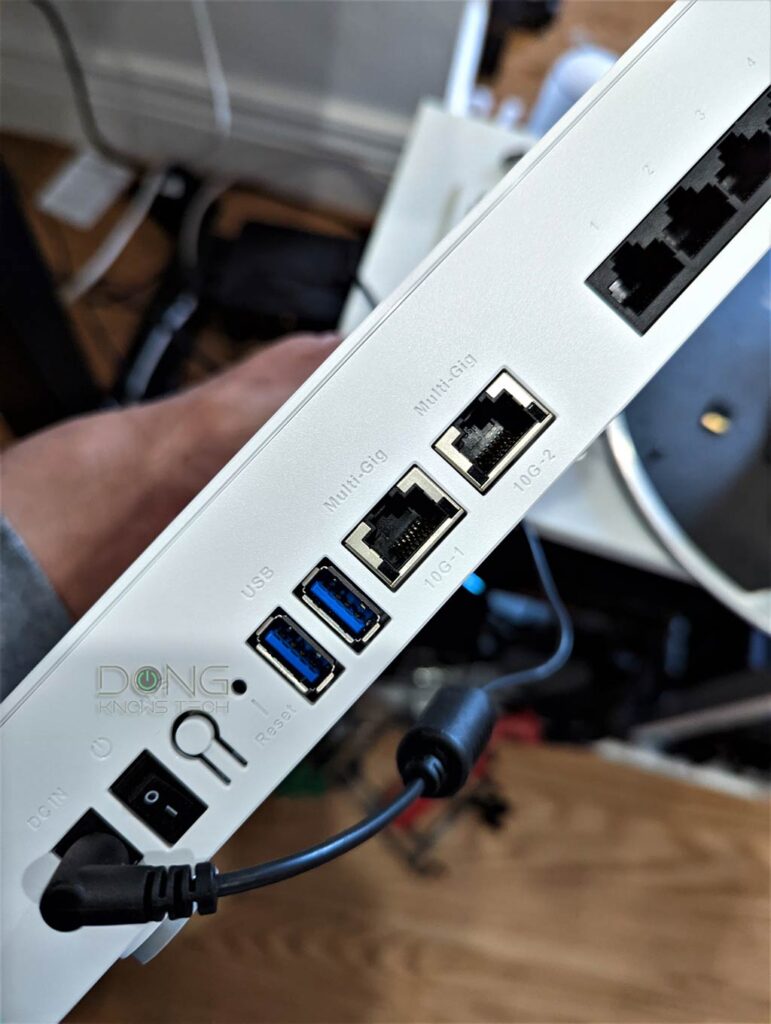
The long answer
For now, it's very channeling to get to even close to sustained 10Gbps Cyberspace. I detailed that in this post of my own experience. That's because:
- The electric current best Wi-Fi speeds (two×ii Wi-Fi 6 or 6E at 160MHz) are sustained at Gig+. So, until Wi-Fi 7 is available, there'due south no manner to meet Multi-Gig sustained speed via Wi-Fi.
- Yous demand 10Gbps equipment throughout out.
- Hardware has overhead.
To have a real Multi-Gig Net connectedness, you lot need a router with at to the lowest degree two Multi-Gig ports. One is for the WAN port (the Fiber-optic ONT) and the other for the LAN side (a Multi-Gig switch).
After that, you need to apply a computer with a Multi-Gig port, and the firm should be wired with CAT6 (or better) cables. CAT5e will besides work but not without some speed reduction.
In the particular case of the Asus GT-AXE11000, or any router with a unmarried Multi-Gig port, the Net connection will cap at 1Gbps.
11. I have a mesh Wi-Fi system, and some devices get disconnected or reconnected frequently at certain locations. Am I crazy?
No, you're not. This is the mysterious yet quite common case where your Wi-Fi works well around the (large) house, just some devices — more oft those from Apple — get disconnected and reconnected at particular locations.
The short respond: Move stuff around a bit!
Move your broadcasters (router or mesh satellites) around a bit, or suit the dBm trigger.
The long answer
When you lot employ multiple broadcasters in a mesh arrangement, the thought is that all of them circulate a single unified network so that devices can become connected every bit they roam around.
In reality, a Wi-Fi client still has to jump from one broadcaster to some other. That'south chosen seamless handoff or roaming assistance.
Handoff tin can be catchy since it depends on both the broadcasters and the device. And when this occurs, the device will have a brief disconnection — the device needs to disconnect from the receding broadcaster and and so connect to some other that'south simply gotten closer.
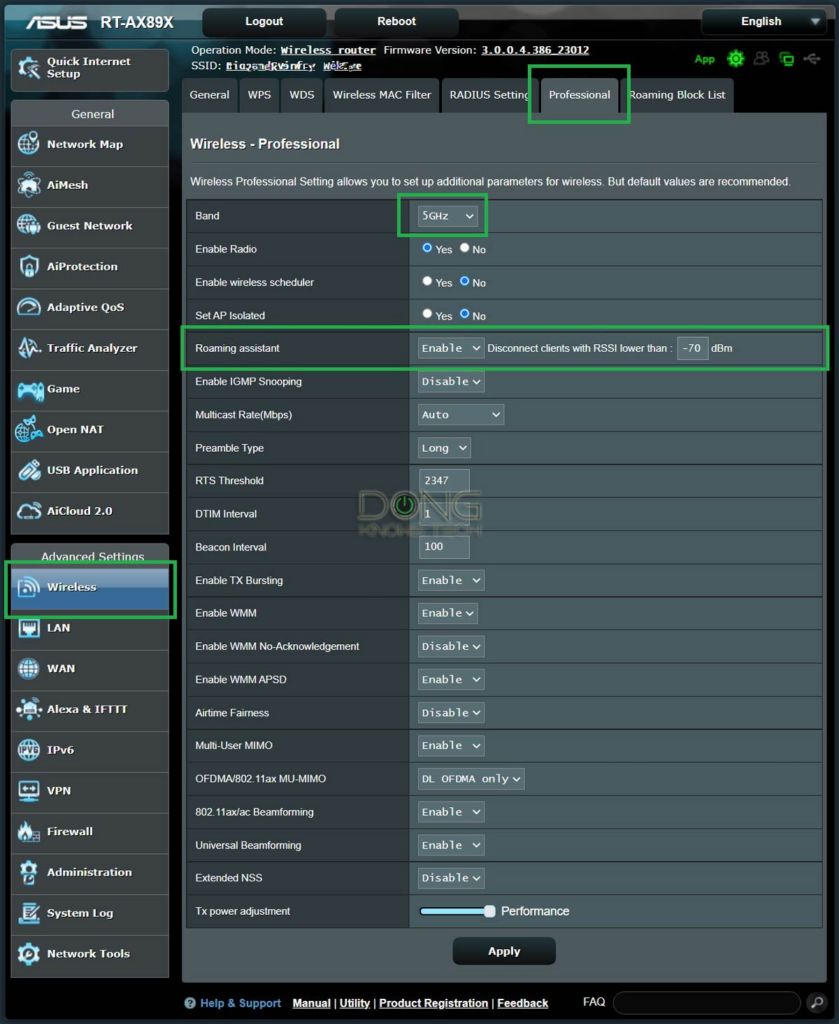
What triggers the handoff is the preset level of dBm, a.one thousand.a the received signal force indicator — RSSI.
I detailed dBm in this mail service, merely the gist is higher the value, the stronger the betoken at which a client would jump — it jumps more often. The lower the value, the more clingy the customer is to its current broadcaster — it might stay connected at a ho-hum speed to the far broadcaster.
If you lot have the dBm trigger at a certain setting and take a customer right between two every bit potent sources of signals, information technology might spring regularly, and that volition crusade disconnections.
The real issue here is there's no concrete solution because it's nuanced. However, changing the dBm trigger value will make a difference. Unfortunately, you tin can do that with only a few mesh brands.
I detailed how to change this dBm value in this post on Asus's AiMesh. With those that don't let y'all to practice that, moving the broadcasters around, sometimes just by a pes or so, will do the play a joke on.
x. I have Gigabit Internet and recently upgraded to a peak-of-the-line Wi-Fi half-dozen router, merely my telephone tin't connect faster than 350Mbps. Why?
This is another assumption like the case of question number 8 below. A connection's speed is that of the lowest political party involved.
The short answer: Get a new telephone!
That's right. You should either get a new telephone — it has to be an expensive 1, too. Or only stop speed-testing already.
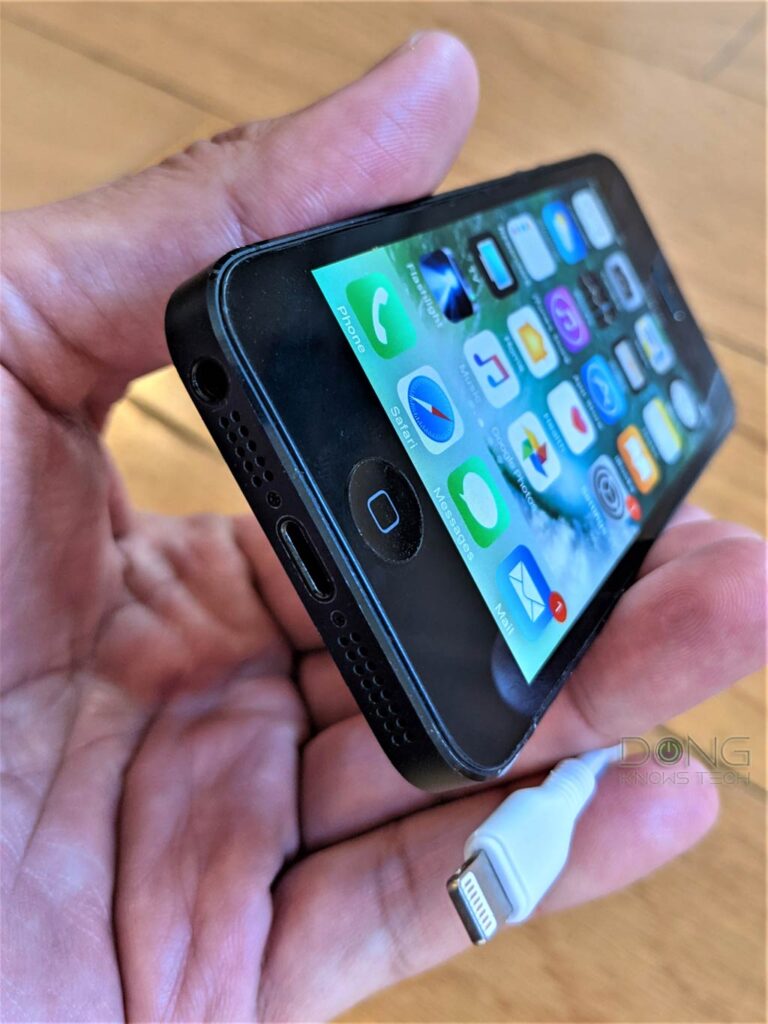
The long respond
I wrote a long piece on Wi-Fi and Cyberspace testing, just the gist is this: The router and your phone are two unlike things. Upgrading 1 doesn't mean the other is automatically up to snuff.
Most chiefly, our phone doesn't need to connect at a super-fast speed — 350Mbps is speedier than whatsoever application would require.
ix. I just got a new (and ameliorate) router, and my 2.4GHz devices have a difficult time staying connected or connecting at slow speeds. What's going on?
This example is when the 2.4GHz ring performs at extremely slow speeds, even when you put the customer close to the router.
Again, we talk farthermost here since this band, by nature, is wearisome. Then exist concerned if y'all tin only connect at around 15Mbps or slower.
The brusque answer: Check the router'southward USB port!
Switch the router's USB 3.0 port to USB 2.0 style when applicative. Or remove the connected USB device from it.
The long reply
This case applies only to routers with a USB 3.0 port and allows yous to manage this port's speed.
Using the router'south USB port in the fast USB 3.0 standard (5Gbps) tin can cause adverse furnishings on its 2.4GHz Wi-Fi band.
I've experienced this in loftier-stop routers from Asus and Synology, but the outcome might be more prevalent.
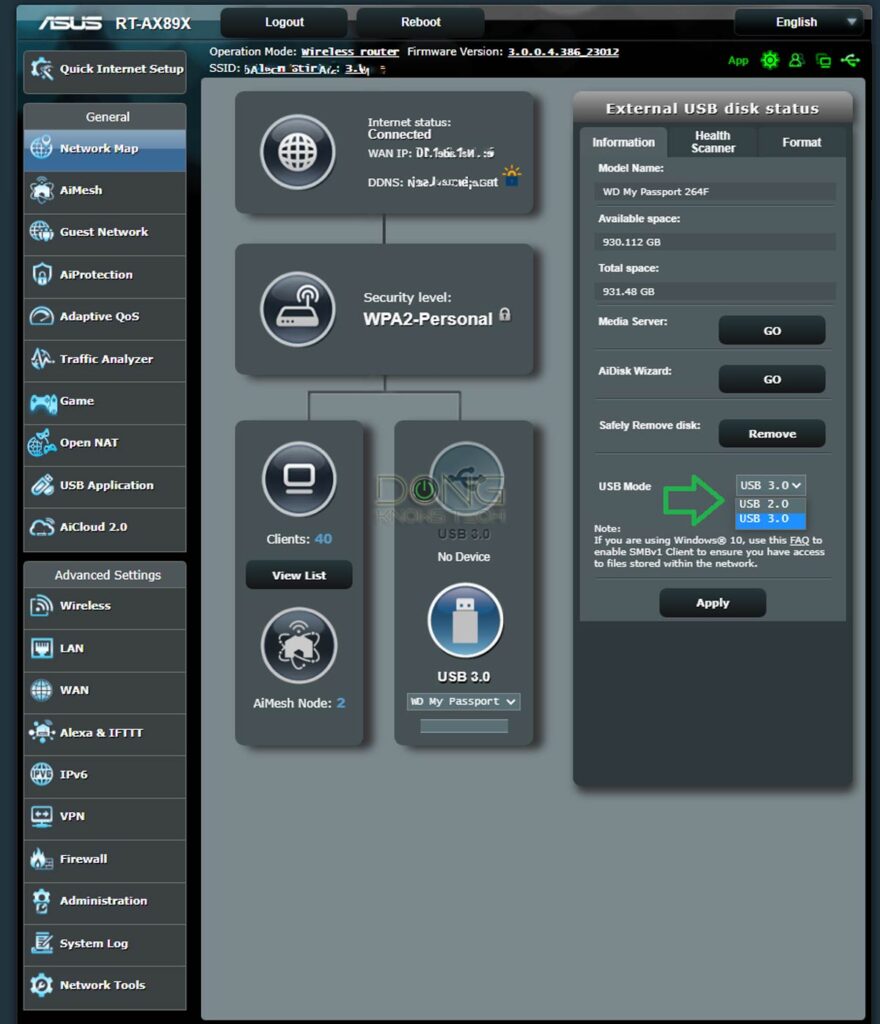
The solution: Utilise the USB port in USB ii.0 mode, which caps at only 480Mbps. You generally can exercise this within the router's web interface, either at the USB or 2.4GHz Wi-Fi section.
This setting is not ideal for those using the router as a mini NAS server since the NAS speed will exist slow. Merely that's merely an example of how we tin't have everything.
8. I just got a brand-new top-tier Wi-Fi router, but my Internet speed doesn't ameliorate. Why?
I got this question a lot. Folks get a new and exciting Wi-Fi router and automatically expect their Internet to be faster. Specifically, they desire it to lucifer the new Wi-Fi speed.
The short answer: How fast is your Net?
It'southward likely your Internet. Wi-Fi tin't increase your Internet speed — but your service provider can.
The long answer
Internet and Wi-Fi are two different things. If you have slow broadband, no Wi-Fi can make it faster.
However, in this case, proper QoS configurations will likely assistance. Also, reduce the number of smart devices, especially cloud-based security cameras, to complimentary up the upload pipe.
Note that using QoS can make your Cyberspace speed seem slower in a speed test.
seven. Fast Cyberspace at the modem (or ONT) but slow via Wi-Fi or even when wired to the router?
This broadband speed discrepancy has been increasingly common as Gigabit-class, Gig+, or even faster Internet access becomes more pop. Here'due south the scenario:
When using the same (wired) client, you get fast Cyberspace straight to the modem (or the fiber-optic ONT) but non via the router.
The brusque answer: Yous might have messed effectually a fleck much.
Check your client's speed form, router's bandwidth control, QoS, MTU, and Jumbo Frame, and use applicable settings.
The long answer
Assuming you already have an fantabulous router. Afterwards that, here are a couple of things to try in this order:
- Turn off, or re-tune, the QoS setting on the router. QoS is an Internet regulating feature, and equally such, it might slow down the broadband speed depending on the application. In whatsoever case, remember that QoS is not intended to brand your Internet faster.
- Ensure that the client you use for testing is the but ane using the Internet. That's because the bandwidth is shared.
- The router must accept a fast WAN port. Information technology has to be 1 of those Multi-Gig-ready routers.
- The Wi-Fi (or wired) connection between the router and the client has certain cap speeds. The signal is that the connection between the router and the client must be the same or faster than between the router and the Cyberspace. So:
- If that's a wired connectedness, make certain it'southward Gigabit or faster — it has to exist at to the lowest degree the same speed grade as your broadband.
- If that'due south a Wi-Fi connexion, keep in mind that 2.4Gbps negotiated is the best for at present (real-earth speed is much discounted) if you use Wi-Fi 6/E. If you take Wi-Fi five, the full general rate is around 800Mbps.
Extra: Jumbo Frame or MTU settings tin can exist the real gear up for a Gig+ and faster network
Jumbo Frame and MTU sound strange — they are not meant to exist popular settings.
Nonetheless, in many cases, enabling Jumbo Frame or setting the MTU to the optimal value is the last crucial step in getting the all-time connectedness speeds.
Yous can observe details on how to do that in this post near treatment MTU and Colossal Frame.
6. A (new) device tin can't re/connect to Wi-Fi?
Bold you're non blocking the device by error, this is likely the upshot with the IP accost puddle.
The short answer: Check the IP pool!
Brand sure the IP accost pool is large enough. Mostly, it's better to have the puddle significantly larger than your total number of devices.
The long answer
By default, nigh routers (or mesh system) limit their IP address pool to accept no more a sure number of clients, like 25, 30, or l — much lower than the total number of IP addresses any router can give out, which is 253.
While it's a proficient thought to have fewer active clients, it'south OK to make the address pool much larger than the number of devices a router tin can handle. That's because non all clients are active at all times.
Besides, sometimes, 1 device might use more i IP address for diverse reasons. And so the pool limit tin can run out earlier than you expect, causing new or returning clients to fail to connect.
That said, information technology's mostly a good idea to set the IP pool limit significantly higher than the number of devices you want to use. For more on IP puddle and the detailed steps to change that, cheque out this post on all things router-related.

Extra: IP lease time and you lot
As you can see on the screenshot above (beneath the IP pool), the IP lease time is the window of time the router will continue an IP for a detail device — even if the device is not continued. The IP will not be available to any other customer during this menstruation.
This menses starts when the device outset connects and won't change until information technology runs out unless you lot restart the router earlier that, which will cause all devices to reconnect with a new lease.
The lease time is used in seconds, and by default, well-nigh routers use the 86400 value (24 hours). And that'south fine for most home apply. But if you lot have an environs where you want the IP to become available immediately, you lot tin reduce that to an hour or two.
When the charter runs out, the customer volition need to reconnect and get a new IP. This process takes a brief 2nd and requires the router and customer to negotiate, then it's not a expert idea to proceed the lease too short.
5. Internet of Things (IoT) smart Wi-Fi devices or legacy devices tin't connect to Wi-Fi?
First of all, when information technology comes to IoT devices, just because they have "smart" on their proper name doesn't mean it's a smart thing to use them. I'm talking about devices that connect to your Wi-Fi network direct.
By the manner, this is the supplement to tip #ii below.
The short reply: "Smart" is subjective.
Don't get cheap smart devices, particularly those from unknown vendors. Subsequently that, use a uncomplicated SSID (Wi-Fi name) and password.
The long reply
In my experience, near smart Wi-Fi devices are terrible and decumbent to security — that's virtually always the case if you lot buy a cheap one of unknown brands.
Only fifty-fifty when you buy one from a reputable company, continue in mind that these devices have depression processing power, so they use minimum specs of Wi-Fi.
As a result, the broadcaster (router) needs to work in a mode that supports the lowest denomination of clients, which is boring. In other words, having these devices in the dwelling might adversely impact the performance of your entire Wi-Fi network.
So my get-go communication is to avoid them. Merely if you still want to use these devices for some reason, the following trick might help.
Uncomplicated SSID
In my experience, the complexity of a Wi-Fi network's name (SSID) and password tin can be why some clients — specially IoT devices — tin't connect to it.
That said, here are the rules for making your Wi-Fi network's name:
- Utilize evidently English messages
- Avoid using special characters or spaces
- Go on information technology curt
For case, instead of using a name like "Dong Knows Tech," or even worse, "Đông Knows Tech ⚡," option "Dong-Knows-Tech" or, improve yet, just "DKT." (Needless to say, the quotes are not role of the names.)
Digit-only password
Every bit for the password, it'south all-time to employ a long string of numbers. You can brand it long and random, and then it'south hard to guess.
Tips on Wi-Fi passwords
When information technology comes to passwords, information technology's e'er virtually keeping information technology a secret that matters. Don't associate complexity with security.
The goal is to make your password hard to guess just easy for you to call up and use. Your countersign shouldn't be so complex that you'd have difficulty using it.
A Wi-Fi countersign that includes letters, numbers, and special characters, tin be a pain, especially when you need to enter it into an IoT device. Consider a digit-simply password.
Here'southward ane of many ways to brand a digit-only countersign random and piece of cake to remember:
Pick a long sentence and utilize each word's letter of the alphabet count to form the countersign.
That'd be 414833545652438 if you pick the previous sentence — employ your own!
Segment the network via SSIDs
If y'all need to use a fancy name and password for your Wi-Fi for one reason or some other, you can create a separate simple Wi-Fi network merely for the devices that can't connect to the fancy i.
In this instance, you can brand a Guest network for this purpose — make sure you plow on the intranet admission. Or you tin can even go an additional access betoken to employ exclusively for IoT and smart habitation Wi-Fi devices.
Many IoT devices only work with the ii.4GHz ring, and then make sure y'all turn this band on and apply the name and countersign rules above.
four. Network printers, IP cameras, etc., become disconnected sporadically?
This is the curious case when those devices piece of work fine when you first set them upwardly, but after a while, y'all tin can't use them even when they remain continued.
The short answer: IP reservation for the win!
Reserve their IP addresses. In other words, you lot want to make sure they connect to the network using the same IP every time.
The long reply
This outcome happens in all devices that use the IP address as the merely way to identify themselves in the network — some devices use something else to avoid this issue.
But this issue will happen in all applications where a fixed IP address is required. Examples are VPN servers (or whatsoever server type) or remote administration.
When its IP changes — ofttimes when you restart the router or the device itself — the device at present appears as a new network device, causing the rest of the network to no longer see it as what it used to be.
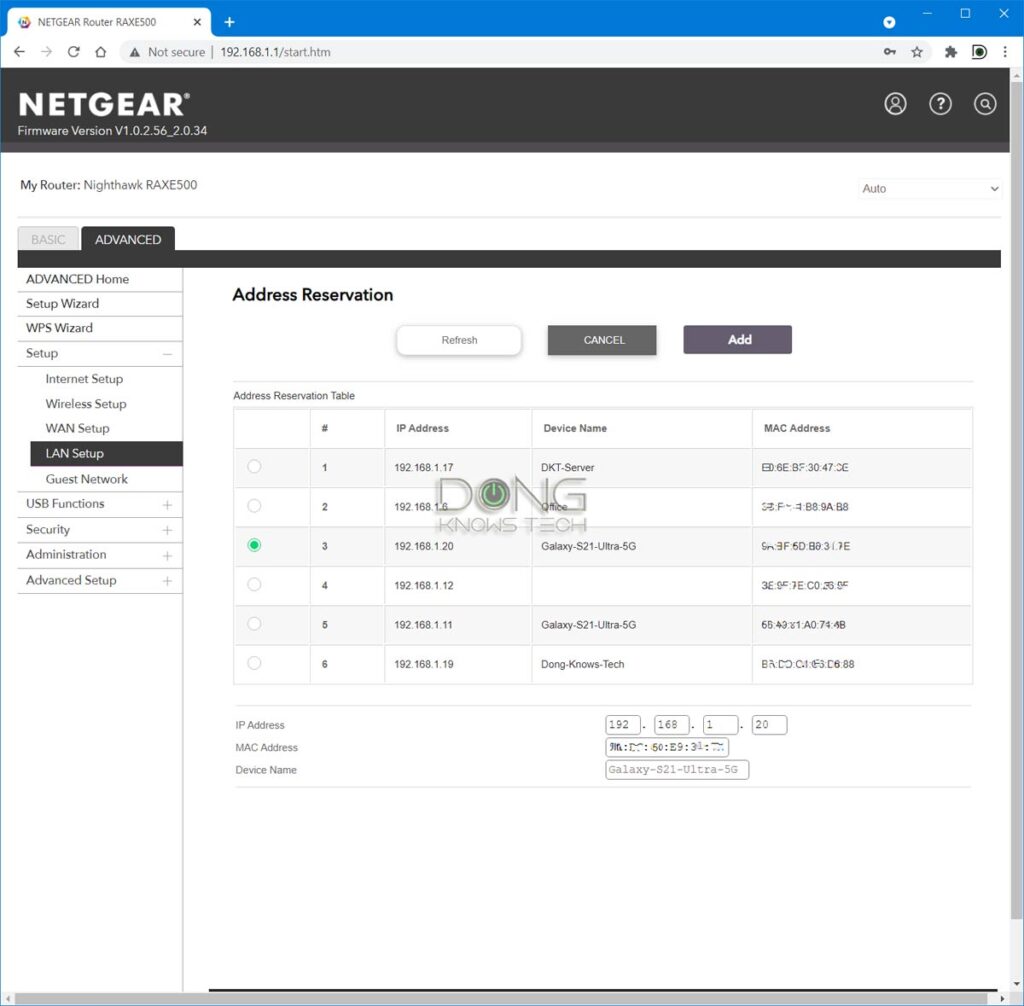
To keep this from happening, yous need to reserve an IP address for the device in question to make certain it has the same IP at all times. IP reservation means you "bind" a item IP address with the device'due south unique MAC address.
Find out more about IP addresses and specific steps for performing IP reserving in this mail service.
On this IP reservation topic, note you can't practise that with most, if not all, Wi-Fi extenders. That's because they automatically give out virtual MAC addresses to their clients.
So, if you demand IP reservations, stop using extenders in your domicile or connect the device in question directly to the router.
3. Intermittent Wi-Fi disconnections on high-stop/new devices?
This issue applies to those with a high-cease Wi-Fi 6 router who experience intermittent cursory disconnections seemingly out of the blueish.
That's likely considering the router works in the 160MHz channel width required for the tiptop functioning.
The brusque answer: Blame the radar!
Avert Dynamic Frequency Option (DFS) channels and utilize the router in 80MHz channel width. Yous can plow off the 160MHz width and use the router in the Machine setting.
The long reply
DFS shares its airspace with radar and, by regulations, takes the back seat. Consequently, a router automatically switches its DFS channels to a free 1 when radar signals are detected.
Clients will experience a cursory disconnection that lasts from a few seconds to even a infinitesimal when this happens. It's a dilemma since DFS channels are necessary for peak Wi-Fi six speeds.
Depending on how frequent radar signals are nowadays, you lot might non fifty-fifty notice the disconnection. Merely if that happens when you're in the middle of a real-time communication app, information technology tin can be frustrating.
Then, if you lot live close to a radar station — within tens of miles — it'due south good not to use DFS channels. Annotation that all airports accept radar, and almost every city has a weather radar station.

Actress: How to not use DFS channels
How we handle DFS depends on the router — some don't back up DFS at all. Generally, you can brand the router ignore all DFS channels or manually pick i not role of the DFS spectrum.
Before doing that, though, note that DFS is simply available in the 5GHz frequency band. Then first, you might need to separate it from the 2.4GHz — turn off Smart Connect, that is — before you tin make specific changes.
After that, keep in mind that the 160MHz channel width requires DFS, so don't use information technology.
Finally, DFS ranges from channel 52 to 144. That means channels outside this range, including 36, 40, 44, 48, 149, 153, 157, 161, and 165, are not role of this spectrum — it'due south condom to use them.
2. Many (legacy) devices can't connect to Wi-Fi?
This upshot happens when you lot upgrade your router to a newer standard. Existing clients might not exist ready for it.
On this front, also bank check out what you lot can do on the client itself below.
The short reply: It's a thing of compatibility
Change the router's Wi-Fi settings to favor compatibility. You can also consider separating its bands (5GHz and 2.4GHz) as different SSIDs (Wi-Fi network).
The long answer
Though all Wi-Fi standards are supposedly backward uniform, the devil is in the details.
That said, if you take a lot of legacy clients, such as Wi-Fi 4 or the first-gen Wi-Fi 5, and get a new Wi-Fi six/East router, you might come across problems if you lot insist on making your router perform at its top speeds.
In this example, it's a proficient idea to make the (new) router friendly to older clients. (More on how to improve issues on the clients' side).
Generally, you can do this in the Wi-Fi or Wireless department of the router'due south interface. There are two things two consider: compatible Wi-Fi settings and ring separation.
Compatible Wi-Fi settings
Note that there are many Wi-Fi settings, and some routers might give you more than others. Also, any of the following items lone might be enough to fix the trouble. So, attempt them out one at a fourth dimension.
- Wireless Mode: Use Mixed or Auto. If you pick a specific standard like 802.11ac (Wi-Fi five) or 802.11ax (Wi-Fi vi), clients of unlike standards won't exist supported.
- Channel width: Choose the value that works for nigh devices. Generally, the Auto setting is the best for compatibility.
- Security level: The level that's balanced betwixt security and compatibility, for now, is WPA2/WPA3. If you lot use WPA3 just, many clients won't be able to connect. But if you choice WPA or lower level, your network is more susceptible to hacking.
- 802.11ax HE frame support: Bachelor in some routers; this setting favors operation for Wi-Fi 6 clients. If you have a lot of Wi-Fi v and older devices, you should turn information technology off.
- Turn on Extended NSS: Not available in all routers, but if yours supports it, it'due south in the advanced/professional area. Also, it'southward likely already turned on by default.
- Smart Connect (when available): This setting combines the ii.4GHz and 5GHz bands into a single Wi-Fi network. It doesn't necessarily amend compatibility, but it helps keep your connection consequent since clients tin automatically switch between the two.
Separate the bands
This setting is the opposite of particular #half-dozen above. I know this is disruptive, but it's best to split each band of a broadcaster into a Wi-Fi network (SSID) of its own in certain situations.
Information technology applies to:
- Y'all have older or unmarried-stream (5GHz or 2.4GHz) clients.
- You have a tri-ring broadcaster with two dissimilar 5GHz bands (Wi-Fi five vs Wi-Fi 6), similar the Asus RT-AX92U or AmpliFi Conflicting.
- You have a traditional tri-band router and desire to utilize one of its ii 5GHz bands in the compatibility mode and the other in operation mode.
- You lot want to accept complete command of which band a client or a group of clients should employ. For example, you lot can make the 2.4GHz for depression-bandwidth IoT devices and 5GHz for high-end gaming rigs.
If you use a tri-band wireless mesh, prepare the backhaul band to exist the fastest supported by the satellites. There's no demand to worry virtually compatibility with this band — information technology works exclusively for the satellites anyway.
1. What's the most of import Wi-Fi setting for the all-time connection speeds? The aqueduct
In that location'southward no curt answer to this.
A Wi-Fi router has iii things to fulfill at whatever given time: The best connectedness speed, the nearly extensive coverage, and the highest client compatibility. The last one is most of import since the beginning two are irrelevant if a client can't connect.
Simply all three are handled with nuances. The most crucial Wi-Fi setting is likely to pick the right channel. By default, nearly routers utilise the "Auto" setting, which means the router itself will determine the best channel based on the real-world condition.
And virtually of the time, that works out. If y'all have a standalone router, that might be all you accept to do.
All the same, a router can only notice the bespeak at its location, not throughout the entire dwelling house. Every bit a outcome, all can be fine when you're near, but as you move further out, your device may showtime disconnecting intermittently.
The disconnection ofttimes happens when you utilise a mesh arrangement with multiple broadcasters at different places around your home. To improve the state of affairs, pick a aqueduct that'south used the least, on average, throughout your area of desired Wi-Fi coverage.
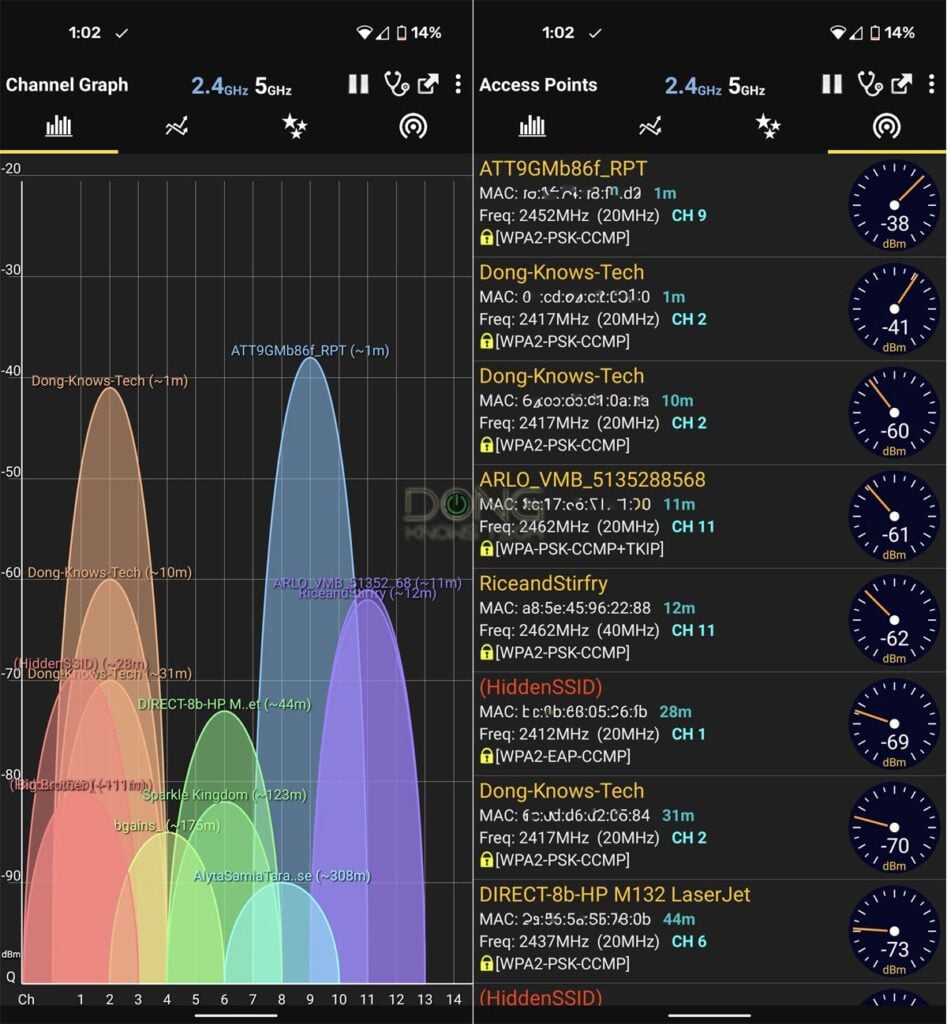
Here's how: Become a free Wi-Fi analyzing app to site-survey the airspace as you walk effectually. You'll be able to "view" the channels in real-time. You'll note that a channel might be completely free at one spot, wholly used at some other, and lightly used at another.
Option the i that's used the least on average. Do that for all the router's bands involved. In a mesh system, the primary router and the satellite(s) will share the same Wi-Fi channel for each band.
(Past the way, to understand the Wi-Fi indicate strength and usage, you demand to know the value of dBm. I explained dBm in detail in this post, but the gist is yous're dealing with a negative number, so the lower the value, the amend the signal is.)
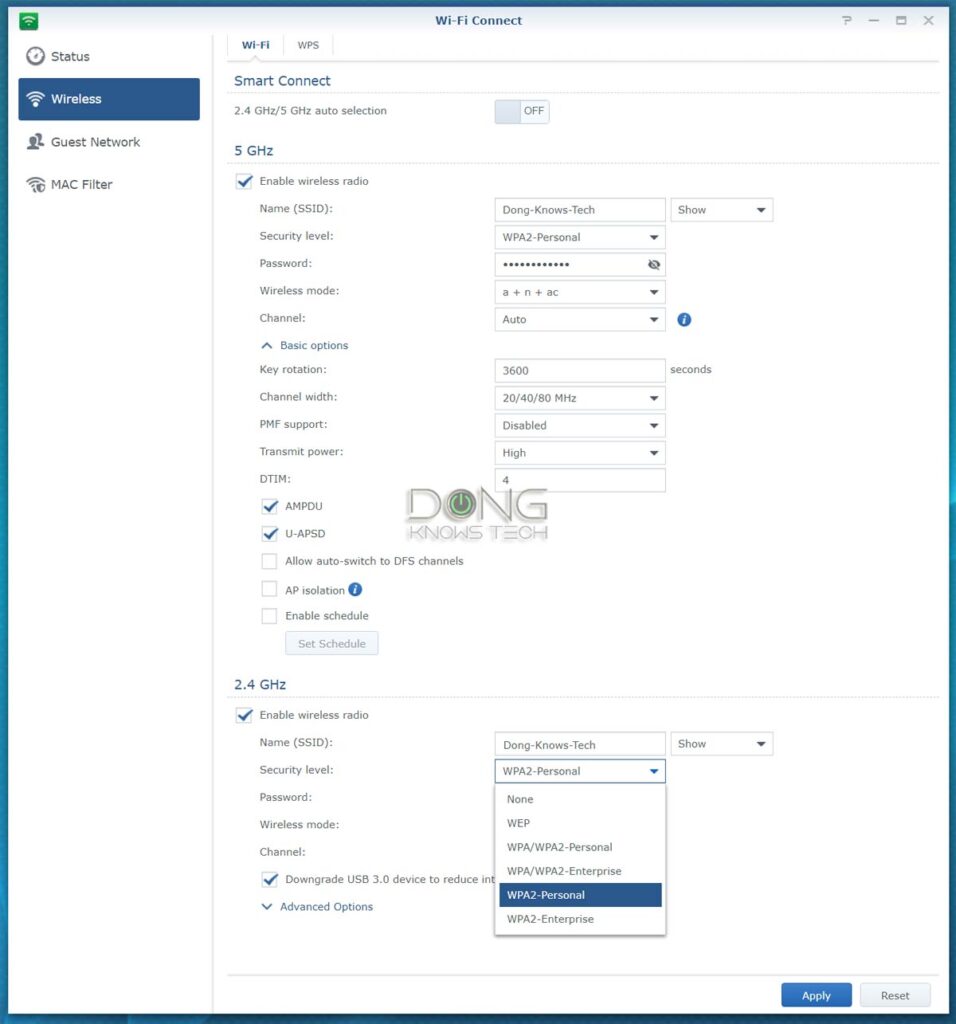
And that'due south information technology. Now cross your finger and utilize the changes to the router when applicative. Hopefully, things are all skilful at present. If not, it's fourth dimension to check on your clients.
Wi-Fi dropping or disconnection repair: What to practise the customer
There are two things nearly the clients, the client itself and the software commuter.
Client's Wi-Fi settings, concrete condition, and protective instance
That said, bank check the client. Is information technology physically intact? If you accept dropped it, that could have caused some hardware parts not to office correctly, and the Wi-Fi adapter might be among those.
Again, check to brand sure you oasis't turned off the Wi-Fi (Airplane style) or manually fix its Wi-Fi to piece of work in a certain way — leave the settings at default unless you know what yous're doing.
If you use a telephone or tablet, keep in mind its protective case adversely affects the wireless reception. All phone cases exercise — it's a thing of degree. More often than not, the thicker the case is, the worse it gets.
Software drivers
Y'all need the latest Wi-Fi driver for each client to piece of work well. The commuter is software that allows a hardware component to work with the operating system.
If y'all're on a Mac, you'll need to upgrade your calculator to the latest version of macOS and also the latest of whatever is offered via Mac Software Update. That's how you can keep your Wi-Fi driver updated. There'due south no other way.
On a Windows calculator or a mobile device, you tin can do a few other things.
(By the way, if you're using the Intel AX210 Wi-Fi 6E adapter, you might want to upgrade your reckoner to Windows 11 or use this detail commuter for Windows 10.)
How to upgrade the Wi-Fi driver on a Windows computer
In Windows 10, yous tin bank check on the commuter of the Wi-Fi adapter the same fashion you do whatsoever other hardware components. Hither'due south how:
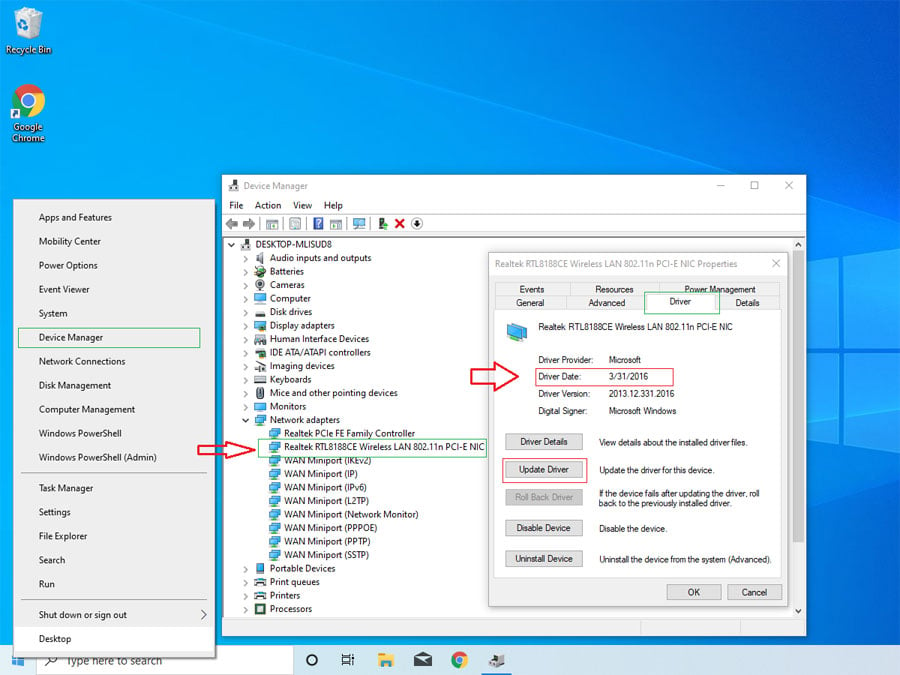
1. Correct-click on the Beginning button (lower-left corner) to bring upward the Windows X bill of fare. (I phone call information technology the "Windows X" menu because you tin can also call it upward using the Windows + X keyboard combo.)
2. On the menu that pops up click on the Device Manager item to bring up its window.
3. On the Device Manager window, navigate to a hardware component in question. In this case, it's 1 of the Network adapters. Choice the Wi-Fi adapter, and double click on it to bring up the Properties window of that device.
4 On the Backdrop window, click on the Driver tab to look at the Commuter Appointment value.
For a Wi-Fi adapter, the driver'southward release appointment shouldn't exist before 2019. If so, it's too erstwhile, and y'all want to try updating the driver. To do that, click on the Update Driver push button, then on Search automatically for updated driver software.
If there's a new driver bachelor, it'll be downloaded and installed automatically. Alternatively, you tin also check the manufacturer's website to encounter if in that location is a new commuter. Download it and install it manually, as I detailed in this post on Wi-Fi 6E driver.
If there'south no driver update and the reckoner'south Wi-Fi doesn't work with your new router, even subsequently you lot take washed all the router-related tricks above, well, you're out of luck. It's fourth dimension to replace that Wi-Fi adapter or the host device.
How to prepare Wi-Fi dropping outcome on a mobile device: Latest updates and reset
You can't update just the Wi-Fi software driver on a mobile device. The but fashion to update anything is to wait for the update pushed out by the manufacturer.
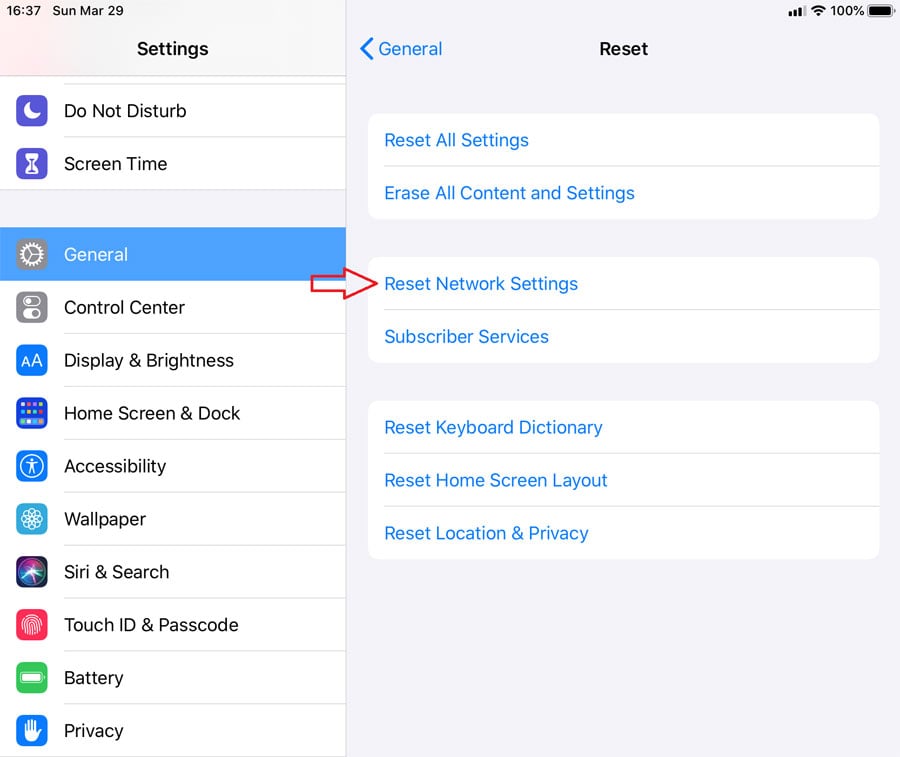
Nonetheless, there are ways to set up your mobile device, especially an iDevice, from Wi-Fi dropping bug, without getting whatever update.
Tips
If you lot take an Apple tree device, including a figurer, and its Wi-Fi connectedness starts acting upward after an Os/Software update when connecting to the aforementioned router, practise this:
Remove your Wi-Fi network from the device in question and re-add it to remove whatever extra erroneous settings caused by the updates.
Hither are a few general things to try — any of them might ready the problem, so try one at a time.
- Restart your device: When did you restart your phone? Exactly! Information technology's a adept thought to shut all open up apps and perform a restart once in a while. That can solve many bug, including those relating to Wi-Fi (and cellular) connectedness.
- Update your device to the latest OS version and patches: This is especially true with incremental updates. The update process will too restart your device, past the style.
- Reset the network setting: This will erase all saved Wi-Fi networks, and you volition need to enter them once more. However, it also removes all incorrect settings that might cause connection issues.
- Reset the device to default: This volition erase everything you have on the device, so make a backup first. This drastic footstep helps refresh your equipment and make it work like new, at its optimal state, including the best possible Wi-Fi support.
The takeaway
Wi-Fi is a lot more complicated than wired networking. For i, it'due south invisible. Yous tin't run into what causes interruptions in the radio waves. So knowing what has gone wrong could be a claiming.
Proper hardware setup on the router and using clients with the latest software are the key to a well-performing wireless network. Besides that, make sure you pick the all-time setting for your particular situation and surround — you're already there.
Most importantly, again, don't expect magic! Take some time and capeesh how the technology has worked for you. A little Wi-Fi dropping and disconnection here and in that location is a pocket-sized price to pay for then much gain y'all've been getting out of it.
Source: https://dongknows.com/how-to-fix-wi-fi-dropping-and-disconnection-issues/
Post a Comment for "Why Does My Netgear Router Just Dtop and Then Start Again"